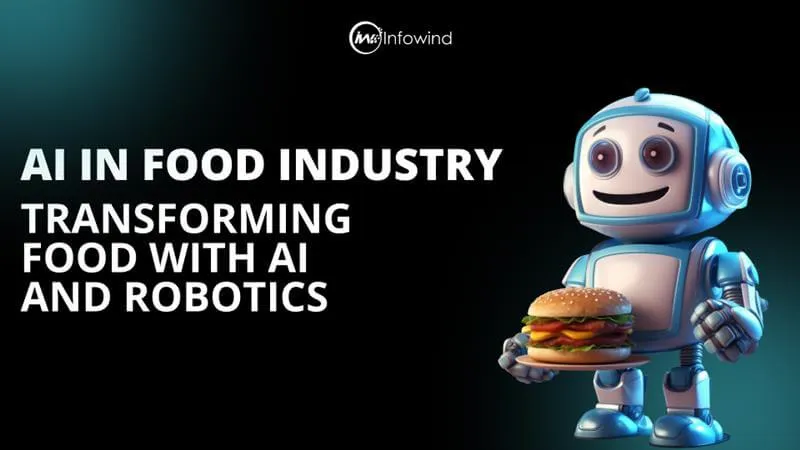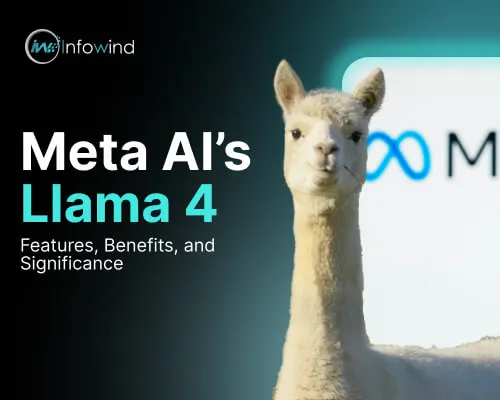Introduction
Artificial intelligence (AI) and robotics are transforming the world’s food sector in ways that were unimaginable a decade or so ago. From how our food is grown and processed to how it’s packaged, shipped, and even served, intelligent machines are transforming what efficiency, safety, and personalization mean in today’s food system.
What was once an industry ruled by individuals’ muscle power, experience, and human instincts is now supplemented with data-based intelligence, automation, and cognitive systems that are capable of thinking, learning, and performing almost like and sometimes better than humans.
In this in-depth blog, we’ll explore how AI and robotics are reshaping every corner of the food supply chain. You’ll discover where these technologies are already being used, the benefits and challenges they bring, and what the future might hold for both businesses and consumers.
What is AI & Robotics in the Food Industry
Before we jump into hands-on uses, let’s define what we’re discussing when we use the terms AI and robots.
Artificial Intelligence is computer software that mimics human intelligence—computers that can analyze data, identify patterns, make forecasts, and even “learn” from experience.
Robotics, on the other hand, is about designing machines to perform physical tasks independently or partly independently. The two technologies combined are a powder keg that can deal with digital intelligence and physical action—something particularly useful in the food industry, where precision, cleanliness, and timing are most important.
Central AI Technologies Driving Innovation
Food technology AI is not one hot tech—it’s an entire array of methodologies and tools, such as:
- Machine learning (ML): Computer software algorithms that learn from examples such as images of produce, ingredient information, or consumer trends to predict outcomes or make better decisions.
- Computer vision: Cameras and sensors that “see” and inspect food—detecting ripeness, freshness, or contamination that the human eye cannot.
- Natural language processing (NLP): Powers chatbots, smart menus, and customized nutrition apps that can interact with customers naturally and conversationally.
Real-World Applications of AI in the Food Industry
Robotics for Automation and Efficiency
- Bots have been used in manufacturing for decades, but AI in restaurants is increasingly encroaching on food production.
- Robot arms execute precision, repetitive, or hazardous tasks like packaging, sorting, cutting, and mixing.
- Autonomous mobile robots do the cleaning, delivering the ingredients, and even meal delivery.
- Collaborative robots (cobots) are designed to work safely with humans, improving productivity while enabling flexibility.
These technologies don’t just replace workers, but AI in the food industry complements them, creating safer, more productive, and more reliable processes from farm fields to factory floors.
Transfiguration Across the Food Value Chain
AI and robots are not specific to a given stage of food production. Their potential could be seen in all steps of the value chain—ranging from planting and harvesting to cooking and serving.
Precision Agriculture: Farming with Intelligence
New farms are becoming high-tech ecosystems. Artificially intelligent drones, soil sensors, and autonomous tractors collect and analyze data on weather, soil condition, plant growth, and pests.
Farmers no longer have to guess. What they get instead is real-time information telling them when to plant, how much water to provide, and where to place the fertilizer. The precision technique gets the most out of yields while using the least amount of water and chemicals.
Some examples in real life are:
- Machine learning programs that use weather and satellite imagery to predict drought or disease outbreaks.
- Computer-vision-enabled drones that detect nutrient deficiency or pest infestation in its early stages, before they spread.
In short, AI is getting farmers to do more with less—an essential step towards world food security.
Smart Food Processing: Quality and Consistency at Scale
Food production is among the most automation-friendly sectors, and AI is pushing it further.
Robotics now performs the majority of repetitive and time-sensitive tasks, such as cutting, sorting, packing, and quality inspection. Meanwhile, AI systems monitor production lines with high-resolution cameras for contamination, irregular coloration, or foreign material—faster and more accurately than ever.
Examples:
- Vision-based quality control systems that can scan thousands of products per minute.
- Mixers and cutters powered by AI that automatically switch for texture and consistency.
Such technologies not only simplify production but also ensure it is safer by reducing human contact with sensitive parts of food handling.
Smarter Supply Chains: Factory to Fork
One of the biggest food industry pain points has always been logistics—how to maintain perishable foods at their best and minimize waste.
AI in the food industry and robotics are also revolutionizing this industry. Intelligent algorithms can predict demand, route optimize, and monitor storage temperatures in real time. That means reduced stockouts, less waste, and lower transport costs.
Blockchain technology is more and more often combined with it to offer transparency, so businesses and consumers can trace every product’s journey from farm field to supermarket shelf.
Examples include:
- Coca-Cola utilizes AI to forecast regional demand, eliminating overproduction and waste.
- Restaurants and retailers have predictive stock systems that replenish leading products automatically and reduce spoiled products.
Supply chains become leaner, greener, and much more resilient with these technologies.
Food Safety and Hygiene: Every Bite Protected
Safety first when it comes to food. One issue of contamination can lead to huge financial and reputational damage.
AI-powered cameras and sensors now monitor everything—from worker hygiene to machinery cleanliness. Systems can detect whether employees are wearing the right protective gear or whether a surface shows microbial growth.
Robotic cleaning systems, meanwhile, ensure consistent sanitation in kitchens and factories. This not only minimizes human error but also maintains higher hygiene standards around the clock.
For instance:
- Lithuanian company Mantinga uses AI video systems to ensure employees follow safety protocols.
- Real-time analytics can detect anomalies in temperature or pH levels, flagging potential contamination instantly.
The result is a safer food environment for both workers and consumers.
Personalized Nutrition and Smart Dining
AI’s impact isn’t limited to back-end operations—it’s also transforming the customer experience.
Consumers increasingly want personalization in everything they buy, and food is no exception. Apps and kiosks powered by AI now recommend meals based on allergies, health goals, or genetics. Restaurants use smart ordering systems that learn customers’ preferences over time, so each meal tastes customized through the food delivery apps.
Robotics is creeping into the front-of-house too, with robotic baristas, burger-flippers, and self-service servers accelerating meals and making AI food technology more predictable.
Examples include:
- Starbucks uses AI to suggest drinks based on weather, time, and local trends.
- Robotic kitchens like Spyce and McDonald’s machines dispense food at lightning speed without sacrificing flavor or accuracy.
This tidal wave of personalization doesn’t just make things more convenient—it also builds stronger customer loyalty.
Benefits of AI in Food Tech
The measurable impact of AI in restaurants and the food industry is already substantial.
1. Increased Productivity and Efficiency
Automation allows food manufacturers to operate 24/7 with less downtime. Productivity improvements of up to 25% are reported in facilities where robots have been installed. Robots don’t get tired, and AI optimizes every step for time and resources.
2. Improved Food Safety
AI systems detect errors and risks before they ever touch consumers. Automation eliminates the number of human hands touching the product, thereby lowering the risk of contamination. Businesses can respond in a second when sensors pick up something amiss, limiting the extent of recalls.
3. Cost Savings
While initial setup costs are significant, long-term savings are enormous. Reduced labor costs, maintenance prevention, and waste minimization all contribute to streamlined operations. AI solutions also cut energy usage by optimizing heating, cooling, and production schedules.
4. Environmental Impact and Sustainability
Sustainability is no longer optional — it’s essential for business success. AI-powered precision farming lowers water and fertilizer use, while supply chains are optimized for a lower carbon footprint. Robotic quality assurance minimizes waste so that more of what’s produced can actually be consumed.
5. Enhanced Customer Experience
From customized menus to faster delivery, AI enhances convenience and satisfaction. Customers enjoy more customized food to their requirements, and companies get more insight into customer behavior, which enables them to deliver better innovation and service.
Challenges and Considerations of AI in Food Tech
Although the potential is tremendous, integrating artificial intelligence in the food industry is not without challenges.
1. Integration and Upfront Investment
For the majority of small or medium-sized enterprises, replacing outdated systems or purchasing robots appears daunting. The good news is that cloud-based and modular AI software is making it less expensive to enter. Companies can start small—perhaps automating a single step—and expand over time.
2. Workforce Disruption
Automation inevitably provokes apprehension about job loss. Instead of taking jobs away, however, many companies are using it to redefine them. Workers are being trained out of traditional labor jobs into data analysis, equipment repair, or system watching—work safer, better-paid, and less likely to be automated.
3. Data Privacy and Security
Given that AI is highly data-dependent, privacy becomes a significant concern, especially with customer dietary or health information. Encryption, compliance with regulations such as GDPR, and the ethical handling of data are essential to gain consumer trust.
4. Algorithmic Bias and Trustworthiness
AI models are only as effective as the quality of the data they are trained on. Poor-quality or biased data can lead to flawed predictions or discriminatory results. For instance, a diet application trained on mostly Western diets can provide unsuitable recommendations for Asian consumers. Regular auditing and input from diverse sources minimize these risks.
The Future of AI in Food
In the years ahead, the marriage of food and technology will continue to strengthen. Some of the newest developments are already shaping what comes next.
1. Recipe and Product Innovation with Generative AI
Think about developing a new snack flavor or protein bar, not from months of trial and experiment but in hours, using AI simulations. Generative AI algorithms can predict flavor profiles, texture responses, and even nutritional profiles, speeding up R&D by orders of magnitude.
2. Scaling Plant-Based and Lab-Grown Foods
With the world needing greener sources of protein, AI food technology is the key to scaling cultured meat and future-generation plant-based foods. They monitor fermentation, control cell growth, and obtain optimum flavor and nutrition—critical to mainstreaming these foods.
3. Rise of Collaborative Robots (Cobots)
Future food plants will see more deployment of cobots—robots that collaborate with humans safely, adapting tasks based on changing assignments without extensive reprogramming. Such marriages of human creativity and robotic precision represent the best of both worlds.
4. Blockchain and IoT Integration
The convergence of AI, blockchain, and IoT (Internet of Things) will redefine real transparency. Any tomato, grain, or fish fillet can potentially be traced to its origin within seconds, ensuring authenticity, safety, and sustainability.
5. Democratization for Small Businesses
Thanks to open-source software, cloud platforms, and affordable plug-and-play robots, even small bakeries, restaurants, and local farms can now leverage the power of AI tools that were once the exclusive province of behemoths like Nestlé or PepsiCo. Democratization is leveling the playing field in awe-inspiring ways.
How to Get Started
For food companies wanting to embark on AI and robotics, success lies in starting on the right foot.
- Assess Your Operations: Identify bottlenecks, redundant work, or safety issues that can be automated.
- Begin Small: Pilot initiatives—perhaps an individual AI quality-check system or automated packer machine—begin small.
- Make Data Ready: Good data is the prerequisite of good AI. Clean, structured data leads to better insights.
- Consider Compliance: Comply with local and global standards for food safety, labor, and data privacy.
- Train Your People: Get workers technically but also culturally prepared for automation.
- Partner Strategically: Collaborate with tech vendors or research institutions focused on food AI solutions.
- Scale up only after winning early. Each successful automation phase can build confidence, improve ROI, and be the foundation for broader digital transformation.
Conclusion
Artificial Intelligence and robots are no longer sci-fi—today they’re here, revolutionizing food manufacturing, production, transportation, and consumption.
From precision farming and robot cooktops to predictive logistics and personalized dining, artificial intelligence in the food industry and technologies are setting a new level of efficiency, safety, and innovation in the global food system.
Yes, there are dangers—everything from cost and integration to ethics and workforce transformation—but the potential paybacks far outpace them. Companies that embrace this revolution early, with balanced combinations of technology and human ingenuity, will not only be competitive but also lead the way to a wiser, safer, and more sustainable food future.
In the end, AI and robotics are not replacing human touch in food—they’re enriching it. By removing drudgery, repetition, and risk from the process, they allow individuals to focus on what truly matters: creativity, care, and connection through food.





